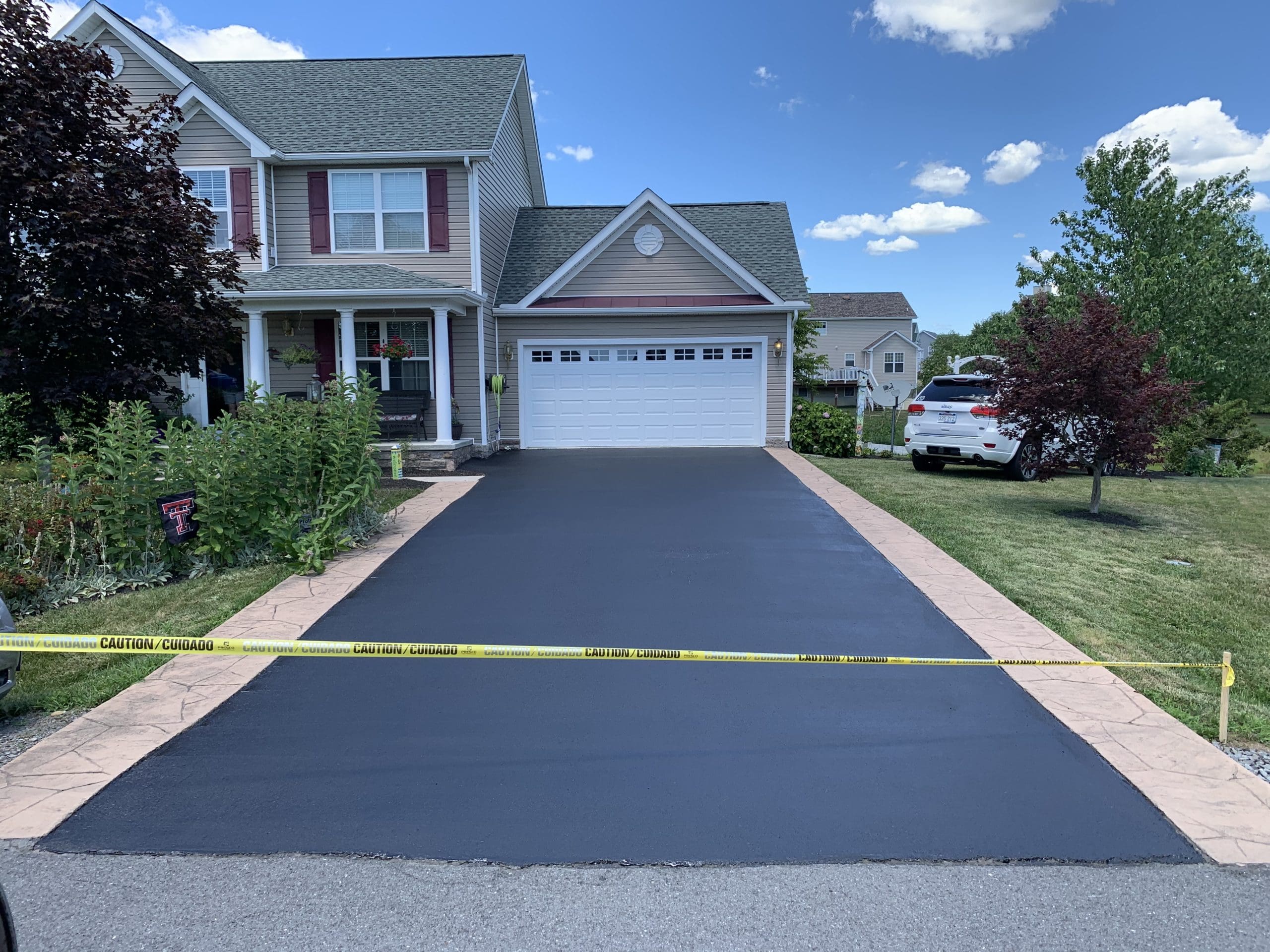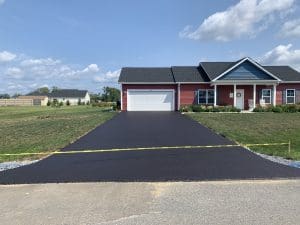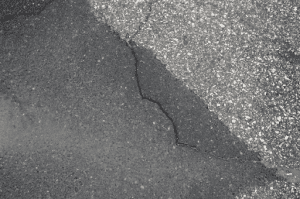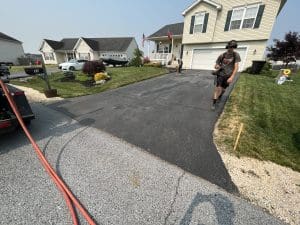Essential Winter Asphalt Maintenance Tips: What You Should Know
Winter brings its unique set of challenges to asphalt surfaces. The amalgamation of freezing temperatures, snow, and ice can inflict substantial harm if not addressed appropriately. In this article, we’ll delve into essential tips for safeguarding your pavement during the cold season, with a special focus on how Top Gun Sealcoating’s services can help you weather the winter with confidence. Understanding the impact of winter on asphalt is pivotal in implementing effective maintenance practices.
Understanding Winter’s Toll on Asphalt
Winter weather presents distinctive hurdles for asphalt surfaces due to the science of asphalt and cold weather. When the mercury plunges, asphalt becomes more brittle and less pliable. This heightened rigidity makes it susceptible to cracking and other forms of damage. Furthermore, the cycles of freezing and thawing can further jeopardize the pavement’s integrity, potentially leading to potholes and surface deterioration.
The Science of Asphalt and Cold Weather
Asphalt is an amalgamation of aggregates, including sand and stone, bound together with a petroleum-based binder. In cold weather, asphalt undergoes a process called thermal contraction. This phenomenon is triggered by the drop in temperature, which diminishes the molecular activity within the pavement. Consequently, asphalt becomes more susceptible to cracking and other types of damage.
During winter, the cold temperatures induce the asphalt to contract, resulting in a decrease in its volume. This contraction can foster the development of cracks as the rigid asphalt struggles to endure the stress caused by temperature fluctuations. These cracks can vary in size, from inconspicuous hairline fractures to more extensive crevices extending across the pavement’s surface.
Moreover, the cold weather impacts the flexibility of the asphalt binder, responsible for holding the aggregates together. As the binder loses its elasticity, the asphalt becomes more brittle and prone to fracturing. This heightened brittleness renders the pavement vulnerable to damage from heavy vehicles, including snowplows, and the weight of accumulated snow and ice.
Common Winter Perils for Asphalt
During the winter season, specific types of damage become more prevalent. One frequent issue is the formation of cracks, a consequence of the asphalt’s expansion and contraction in response to temperature fluctuations. These cracks can serve as conduits for water infiltration, leading to further deterioration. Additionally, the weight of snow and ice can generate surface depressions and indentations, often referred to as “alligator cracking.”
“Alligator cracking” presents a distinctive pattern of interconnected cracks resembling the skin of an alligator. This form of damage is typically induced by the repeated freezing and thawing of water within the pavement. As water freezes, it expands, exerting pressure on the surrounding asphalt. Upon thawing, the pressure is released, causing the pavement to crack and degrade over time.
In addition to cracks and alligator cracking, winter weather can instigate the emergence of potholes. Potholes are depressions within the pavement that emerge as the asphalt deteriorates and fragments. The freezing and thawing cycles, coupled with vehicular traffic, can weaken the asphalt and eventually lead to pothole formation.
Furthermore, the accumulation of snow and ice on the pavement can exacerbate these problems. The weight of the snow and ice adds stress to the already compromised asphalt, escalating the likelihood of cracks, alligator cracking, and potholes. Additionally, the utilization of snowplows and de-icing substances can inflict further harm on the asphalt surface, as the plow blades and chemicals may scrape and erode the pavement.
Preparation for Winter with Top Gun Sealcoating
Before winter’s arrival, it is imperative to examine your asphalt pavement and perform essential repairs. Taking proactive measures will help prevent minor issues from escalating into major problems.
Comprehensive Inspection and Assessment
Commence by conducting a thorough inspection of your asphalt surface to identify any existing signs of damage, such as cracks, potholes, or drainage complications. These issues can worsen during winter due to the expansion and contraction induced by freezing and thawing cycles.
Identifying these problems early on enables you to address them proactively before winter sets in. Walk the length of your pavement, scrutinizing every section, with particular attention to areas that bear heavy traffic or are susceptible to water pooling.
If you detect significant damage or are uncertain about assessing your pavement, it is advisable to engage an asphalt professional. They possess the expertise and experience to uncover underlying issues that may elude an untrained eye.
Requisite Repairs Before Winter
Following your inspection, proceed with the repair of any identified issues. Utilize suitable asphalt patching materials to fill cracks and potholes. It is essential to select the appropriate material for each task, as different crack types necessitate distinct repair techniques.
Ensure thorough compaction during crack and pothole repair to prevent water infiltration. Water penetration into these openings can lead to further damage as it freezes. Utilize a tamper or compactor to ensure the patching material is tightly compressed and level with the surrounding pavement.
In addition to addressing cracks and potholes, it is vital to tackle drainage issues before winter. Clear clogged drains and gutters to facilitate proper water flow away from your pavement. Inadequate drainage can result in standing water, which can expedite pavement deterioration during freezing temperatures.
If your pavement consistently experiences water pooling, contemplate the installation of additional drainage solutions like French drains or catch basins. These measures will deter water from seeping into the asphalt and causing structural damage.
By dedicating time to inspect your asphalt surface and conduct necessary repairs before winter arrives, you are investing in its long-term durability and resilience. Proper maintenance and proactive measures will ensure that your pavement can withstand the rigors of winter, reducing the need for extensive repairs in the future.
Essential Winter Asphalt Maintenance Practices with Top Gun Sealcoating
To uphold your asphalt pavement’s condition throughout the winter, it is imperative to implement key maintenance practices.
Regular Snow and Ice Removal
Frequent removal of snow and ice is paramount for maintaining safe and operational asphalt surfaces during winter. Employ non-metallic snow shovels or plows to avoid harming the pavement. Administer de-icing materials judiciously and in compliance with local regulations to minimize potential damage to the underlying asphalt.
Managing De-icing Chemicals
De-icing chemicals, such as rock salt or calcium chloride, are frequently employed to melt snow and ice. While effective, these chemicals can expedite asphalt deterioration if not used with care. It is imperative to adhere to manufacturer instructions and abstain from excessive application. Following winter, execute a thorough pavement cleaning to eliminate any residual chemicals and diminish long-term damage.
Post-Winter Asphalt Care with Top Gun Sealcoating
Once winter has run its course, it is pivotal to assess any damage that may have transpired and devise a plan for requisite repairs.
Assessing Winter Damage
Conduct an inspection of your asphalt pavement after winter to pinpoint any new cracks, potholes, or other forms of damage that may have materialized. Document areas in need of attention and collaborate with an experienced asphalt professional to gauge the damage’s severity. Swift assessment will enable you to strategize for appropriate repairs and stave off further deterioration.
Planning for Spring Repairs with Top Gun Sealcoating
Based on your evaluation of winter damage, construct a comprehensive plan for spring repairs. Prioritize the most critical issues, such as substantial potholes or extensive cracking, and allocate the budget for necessary repairs. Enlisting a reputable asphalt maintenance company guarantees that the proper techniques and materials are deployed to restore your pavement effectively.
Professional Asphalt Maintenance Services with Top Gun Sealcoating
In certain instances, seeking professional asphalt maintenance services is advantageous for your winter asphalt needs.
When to Enlist Professional Assistance
If you lack the expertise or resources to carry out thorough inspections, repairs, or post-winter evaluations, it is prudent to seek professional assistance. Seasoned asphalt maintenance companies possess the knowledge, skills, and equipment requisite for efficiently tackling asphalt maintenance tasks.
Selecting the Right Asphalt Maintenance Company
When electing an asphalt maintenance company, consider their reputation, experience, and array of services. Scrutinize reviews and testimonials from previous clientele to affirm their reliability and work quality. Obtain detailed quotations and make comparisons to identify the service provider best suited to your requirements and budget.
By comprehending the impact of winter on asphalt, prepping your pavement, implementing crucial maintenance practices, and contemplating professional services when necessary, you can safeguard the durability and resilience of your asphalt surfaces throughout the winter season. Initiate proactive measures to shield your investment and preserve the functionality and safety of your asphalt pavement with Top Gun Sealcoating by your side.




